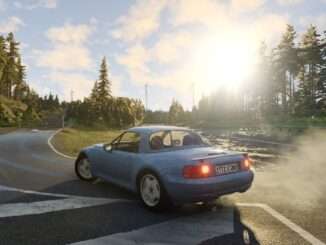
I hope this helps people. I am by no means a specialist but I’ve been fixating on BeamNGs tuning for around 250 hours. I’ve had my notes checked and it’s all correct.
- Toe in – is + Adjustment
- Toe out – is – Adjustment.
Table of Contents
General Tuning and the Effects on the Vehicle
Anti-Roll Spring Rate:
Increased: Reduces body roll during cornering, enhancing stability and potentially increasing grip. However, an overly stiff setting may decrease grip on uneven surfaces, cause understeer or negatively affect ride quality.
Decreased: Allows more body roll, which could lead to more weight transfer to the outside wheels and potentially induce oversteer. It could also improve mechanical grip on uneven surfaces due to increased wheel articulation but may reduce cornering stability as the center of gravity moves more during cornering.
Spring Rate:
Increased: Reduces body roll and dive under braking, improving handling responsiveness and stability. However, it may lead to a harsher ride and less grip on uneven surfaces due to less wheel compliance. Too high a spring rate can also make the vehicle overly responsive to steering inputs, making it twitchy or jumpy, especially at high speeds.
Decreased: Increases body roll and nose dive during braking. This can make the ride more comfortable by absorbing more of the road’s imperfections, but it may reduce handling responsiveness by allowing more movement of the car’s body, which can reduce the tire’s contact patch during cornering.
Camber Adjust:
Increased Negative: Tilts the top of the tires inward. This improves cornering grip by increasing the contact patch during cornering. Too much negative camber can reduce the straight-line grip.
Increased Positive: Reduces grip. However, it might enhance straight-line stability.
Caster Adjust:
Increased: Enhances high-speed stability and cornering grip due to an increased self-centering effect of the steering, giving the car better directional stability. However, it might make steering feel heavier, especially at low speeds or during parking maneuvers, and potentially increase tire wear due to increased load on the tires.
Decreased: Reduces high-speed stability and self-centering effect, making steering feel lighter and easier. However, it could reduce cornering grip due to a less effective tire contact patch with the road.
Toe Adjust:
(Slider positive) Toe-in: Angles the fronts of the tires towards each other, improving straight-line stability but potentially decreasing cornering precision by helping the vehicle resist veering to either side
(Slider Negative) Toe-out: Aims the front of the tires away from each other, enhancing cornering responsiveness and precision, but potentially compromising straight-line stability
Wheel Offset:
Negative: improving cornering grip. Can increase the scrub radius, leading to greater steering effort.
Positive: Generally found on front-wheel-drive cars and newer rear-drive cars. Potentially improves high-speed stability. Might reduce cornering performance
Bump Damping and Rebound Damping Effects
Bump Damping:
Increased: Provides greater resistance during suspension compression, which improves vehicle stability during weight transfer events like acceleration, deceleration, and cornering and reduces body roll. Generally improves responsiveness but makes the ride feel stiffer and possibly harsher over bumps. It can also lead to reduced grip on rough or uneven surfaces due to stiffer setup hindering wheels to quickly adapt.
Decreased: Less resistance during suspension compression, which allows for a smoother ride over bumps, but may lead to more body motion and perceived instability. Increased weight transfer potentially reducing handling predictability during aggressive driving.
Rebound Damping:
Increased: Delays the extension of the suspension after compression, This can help to stabilize the vehicle by controlling weight transfer during cornering, acceleration, and braking. Too much rebound damping may reduce wheel contact with the ground after hitting bumps, reducing grip, and making the ride feel harsher.
Decreased: Allows quicker extension of the suspension after compression, which can help to maintain wheel contact with the ground after bumps providing a softer ride and better absorption of sudden weight transfers, improving grip, but may lead to a bouncy feeling or unstable ride, as the suspension may not control the weight of the vehicle effectively.
Front and Rear Tuning Effects (Drift Tuning)
Front Suspension
Front Anti-Roll Spring Rate:
Increased: Encourages weight transfer to rear wheels during acceleration, promoting oversteer and aiding drift initiation. Excessive stiffness could lead to understeer and harm front-end grip, especially on uneven surfaces.
Decreased: May increase front-end grip and improve steering response, though it could potentially hinder ease of initiating drifts due to greater traction.
(More grip at the front could also aid in better steering response and front-end bite in the initiation phase of a drift.)
Front Bump Damping:
Increased: Provides stability during suspension compression, such as hitting bumps or changing directions mid-drift. Too much could lead to harsh ride and reduced contact patch, adversely affecting control.
Decreased: May offer a more compliant ride over rough surfaces and enhance road contact during drift, though it could introduce instability or unpredictable behavior, especially on bumpy tracks.
Front Rebound Damping:
Increased: Helps to control weight transfer effects and settle the car quickly after maneuvers. However, excessive rebound damping could limit suspension travel, impairing grip.
Decreased: Enables faster suspension extension after compression, improving road contact after bumps. Too little could lead to a floaty ride and reduce control, especially during weight transfer.
Front Spring Rate:
Increased: Promotes weight transfer to rear wheels, aiding oversteer initiation. However, excessive spring stiffness could make the car jumpy or overly sensitive to steering inputs.
Decreased: Increases front-end compliance, potentially enhancing grip and steering response, though it could make drift initiation more difficult due to less weight transfer.
Front Camber Adjust:
Increased Negative: Enhances grip when steering input is applied, providing better control during a drift.
Increased Positive: Rarely used in drifting, as it typically reduces grip during steering input.
Front Caster Adjust:
Increased: Provides better self-aligning torque, improving steering feedback and directional control during a drift. This makes it easier to control and recover the car during a drift.
Decreased: Could make steering feel lighter and reduce feedback.
Front Toe Adjust:
Toe-out: Enhances steering responsiveness, which can help in initiating and controlling drifts.
Toe-in: Rarely used in the front for drifting, as it typically reduces steering responsiveness.
Rear Suspension
Rear Anti-Roll Spring Rate:
Increased: Stabilises the vehicle during a drift by reducing body roll. Too much could hinder the ability to maintain drift.
Decreased: Could allow for more dynamic weight transfer and enhance oversteer, useful for maintaining drifts. Too stiff can cause tires to lose contact, reducing grip.
(A softer setting could lead to more body roll, which could potentially unsettle the car during a drift if it’s excessive.)
Rear Bump Damping:
Increased: Provides stability during weight transfer and transitions, aiding control during a drift. Too much could cause a harsh ride and reduce grip.
Decreased: Allows for more compliance and road surface tracking, though it could introduce instability during weight transfer or transitions.
Rear Rebound Damping:
Increased: Helps to control weight transfer effects and stabilise the car quickly after maneuvers. However, excessive rebound damping could limit suspension travel, reducing grip.
Decreased: Enables quicker suspension extension after compression, improving road contact. Too little could result in a bouncy ride, impairing control.
Rear Spring Rate:
Increased: Promotes quicker weight transfer, aiding drift initiation. However, too stiff could lead to reduced grip on uneven surfaces.
Decreased: Enables smoother, albeit slower, weight transfer. While it can make drift initiation slower, it could potentially enhance control and predictability during sustained drifts.
Rear Camber Adjust:
Increased Negative: Rarely used in drifting for the rear, as it might increase grip and resist oversteer.
(It might be beneficial in some cases to have a slight negative camber to maximise tire contact during body roll)
Increased Positive or Zero: More common for drifting to enhance slip angle and promote oversteer.
Rear Toe Adjust:
Toe-in: Provides stability during a drift, helping to maintain a controlled slide. This can also help in transitioning between drifts.
Toe-out: Rarely used in the rear for drifting, as it typically makes the car’s rear end behavior more unpredictable.




Be the first to comment